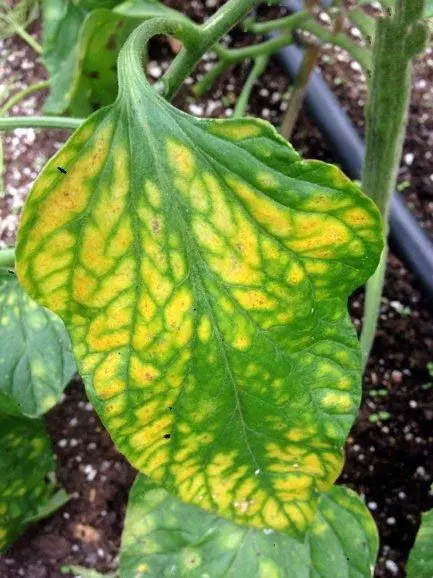Are you noticing your tomato leaves turning yellow? Don’t panic. Yellow tomato leaves can be caused by various reasons, including nutrient deficiencies, watering stress (too dry or overwatering), pests, diseases, and environmental factors such as a heat wave. However, by identifying the underlying cause, you can take the necessary steps to treat your yellowing tomato plants and restore their health.
In this step-by-step guide, we will walk you through the most common reasons for yellow tomato leaves, along with effective treatments to prevent and fix this problem which affects the yield of your tomato crop. We’ve covered you, from soil amendments to natural pest control methods. Whether you’re a seasoned gardener or just starting, this guide will help you keep your tomato plants healthy and vibrant all season. So, let’s dive in and learn how to treat yellow tomato leaves!
Table of Contents
Yellow Tomato Leaves: Why Are They Turning Yellow?
Yellow Tomato Leaves: Why Are They Turning Yellow? Chlorosis in tomato plants or the appearance of tomato plant leaves turning yellow, is a common symptom once the plant starts to develop and emit its first flower bunches.
However, it is not always due to a single cause but to several variables, such as lack of nutrients, pest and disease activity, or atmospheric conditions (cold, drought stress, or lack of lighting). Nowadays, these intense heat waves that we suffer also affect the plants in our gardens. And in the case of tomato plants, if they are in pots, we can bring them indoors, but those growing in our garden are exposed to atypically high temperatures for several days. This can cause the presence of dry flowers on tomato plants and yellowing leaves due to the intense heat.
There are several reasons why the leaves of tomato plants turn yellow. Let’s start reviewing common causes of yellow tomato leaves and how to treat them.
Yellow Tomato Leaves Due to Irrigation
Overwatering or underwatering your tomato plants can cause yellowing of the leaves.
Excess Water
Yellow tomato leaves due to excess water: The leaves look yellow and pale, apart from the fact that you know perfectly well how often you water your tomato plants. Excess water causes the roots to rot (little by little) and can also cause fungus.
When tomato plants are overwatered, the roots become waterlogged and can’t absorb nutrients. This leads to yellowing of the leaves.
How to fix yellow tomato leaves due to excess water: If you have a pot, and you can put drainage without suffering the plant, well, if not, you already know for the next time. If it is a pot or container, check that it has holes in the bottom and raise the container a few inches off the ground so that the water will be eliminated little by little. You can also add sand to the substrate to absorb excess water.
Lack of Water
Now let’s go to the opposite of the above.
Yellow leaves on tomato plants due to lack of water: The leaves dry out, and some are crunchy. When tomato plants are underwatered, they become stressed, and the leaves start to curl and turn yellow.
Learn more about Leaves Curl Up on Tomato Plant – 5 Reasons
How to fix yellow tomato leaves due to lack of water: Water with more water and regularly. Remember that the water must penetrate the root to be absorbed. Also, try to avoid the hottest hours of the day, you may water correctly, but most of it will evaporate.
Yellow Tomato Leaves Due to Lack of Light
Due to lack of light, yellow tomato leaves look discolored and decayed. Remember that the ideal is 5 hours of sun for tomato plants so that the tomatoes evolve correctly, although, with some less, they also develop.
To fix this problem, change the location of your tomato plants. If they are planted in the ground and already have a flower, forget you should not repot it because surely, you will ruin the fruit, and it is not worth it. Try to pamper them so that they evolve and give fruit in the place you have them, and for the next plantation, you already know to write it down.
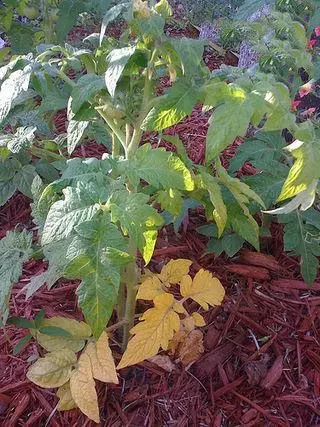
Yellow Tomato Leaves Due to Pests and Diseases
Yellow Tomato Leaves Due to Pests and Diseases. Pests and diseases can also cause yellowing of the tomato leaves.
Leaf-eating Insects
Usually, small insects devour the leaves or suck the sap under the tomato leaves, leaving it yellow until it becomes transparent.
Aphids, spider mites, and whiteflies are common pests that attack tomato plants. These pests suck the sap from the leaves, causing them to turn yellow. Diseases like verticillium wilt and fusarium wilt can also cause yellowing of the leaves.
Use an ecological insecticide such as Neem oil or apply potassium soap. This will eliminate the insects that cause yellow leaves on tomatoes. Follow this link to learn How to Use Neem Oil on Tomato Plants.
Yellow Tomato Leaves Due to Lack of Nutrients
Nutrient deficiencies are one of the most common causes of yellow tomato leaves. Tomatoes require a balanced diet of nutrients like nitrogen, phosphorus, and potassium.
A lack of any of these nutrients can cause yellowing of the leaves. The yellowing of older leaves characterizes nitrogen deficiency, while phosphorus deficiency causes the yellowing of younger leaves. Potassium deficiency causes yellowing of the leaves in between the veins.
Yellow tomato leaves due to lack of nutrients. Nutrients are essential, and you must incorporate them in many cases. This often happens when you grow in containers such as grow tables or pots, and the plant consumes the nutrients before the fruit ripening cycle is finished. Learn more about Nutrient Deficiency in Plants.
Learn more about How To Fertilize Tomatoes – Big Tomatoes
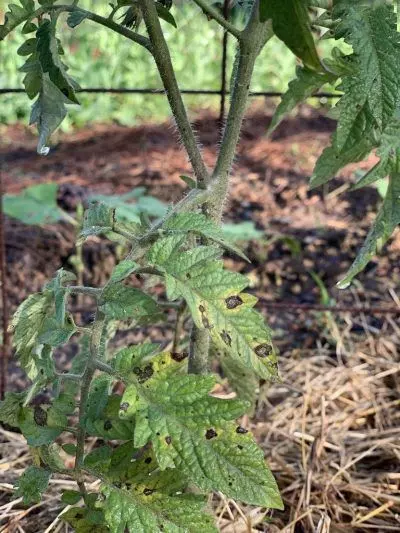
Yellow Tomato Leaves Due to a Lack of Nitrogen
Nitrogen deficiency presents a generalized lack of growth and problems in sprouting. Yellow leaves on tomato plants appear all over the plant, both young and adult leaves. Plant stunting reveals nitrogen deficiency compared to other element deficiencies.
The yellowing of older leaves characterizes nitrogen deficiency.
Lack of Magnesium in the Orchard
Magnesium deficiency is manifested by yellowing the old leaves, keeping the nerves green. It is usually common in acid soils with a sandy texture, especially when high amounts of potassium are applied in cold and humid periods.
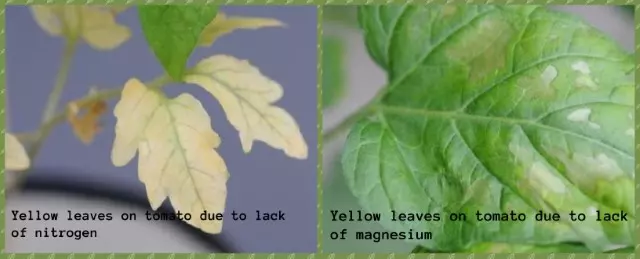
Lack of Sulfur
Sulfur deficiency is rare since many fertilizers contain this element in their composition. It starts with yellow leaves on young tomato leaves, much like nitrogen, and appears in hefty soils with low oxygenation.
Lack of Potassium
Potassium deficiency also causes yellow tomato leaves, starting on adult leaves and edges. As the deficiency progresses, necrotic spots form and form wounds. It can occur in soils of acid pH and sandy texture, with high magnesium content and fruit load.
Potassium deficiency causes yellowing of the leaves in between the veins.
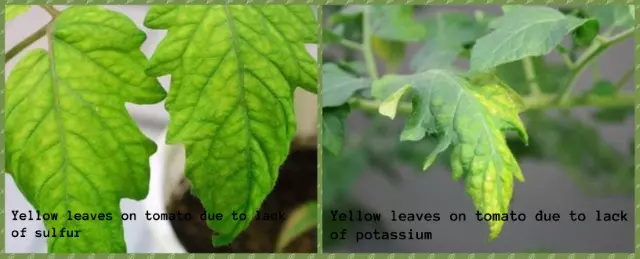
Lack of Zinc
Zinc deficiency in tomatoes creates chlorosis in the midrib in the form of spots or thickened spots, resulting in a chlorotic halo on a dark-colored leaf. This tomato chlorosis usually occurs in high pH, phosphorus-rich soils, and cold conditions.
Yellow Tomato Leaves Due to a Lack of Iron
Iron deficiency in tomatoes is frequent, starting with chlorosis in the leaflet and leaving the nerves green. Subsequently, it ends in completely yellow leaves. Iron chlorosis usually occurs in soils with an alkaline pH, calcareous type, and low oxygenation.
Learn more about What is ferrous sulfate iron used for?
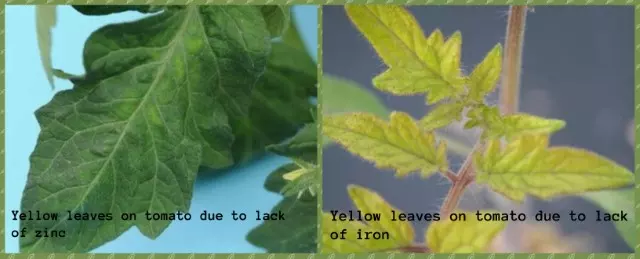
Yellow Tomato Leaves Due to Environmental Factors
Environmental factors like extreme heat or cold can cause yellowing of the tomato leaves.
When tomato plants are exposed to extreme heat, the leaves wilt, turn yellow, and eventually brown.
On the other hand, exposure to cold temperatures can cause the tomato leaves to turn yellow and drop off.
Phytotoxicity on Tomato Plants
Phytotoxicity in tomato plants is the result of causing leaf burn by an inappropriate nutrient mixture. Some incompatible mixtures in foliar treatments cause leaf problems, such as mixing mineral oils and coppers or sulfurs.
On the other hand, not controlling the pH in the foliar treatment and having an excessively acidic application mixture can also create phytotoxicity due to excess acidity. The result is generalized chlorosis, where yellow leaves are observed in tomatoes, sometimes with small brown spots.
However, yellow tomato leaves are quite different concerning nutritional deficiencies. In this case, concentrated spots are observed as dots or a superficial type, as if they had been burned.
Solution: There is no solution for phytotoxicity on already affected tomato leaves. The only thing we can do is to encourage the sprouting of new leaves and energetically stimulate the tomato plant. It is common to use a fertilizer suitable for tomato plants.
- Jack's Classic Tomato FeED 12-15-30 is formulated for vigorous plant growth from roots to green foliage, abundant flowering and fruit set for all tomato varieties and blooming vegetables.
- Includes a formula containing a micronutrient package of nutrients including Magnesium and Calcium. Magnesium helps with improved feeding results, under diverse soil and growing conditions. Calcium is an effective nutrient to help prevent blossom end rot.
- This 1.5 lb. tub of water soluable fertilizer can be used on all tomatoes, peppers, cucumbers, eggplant, squash and zuccini to help ensure continued growth and radiant health in your garden and backyard.
How to Treat Tomato Plant Leaves Turning Yellow
Here’s a step-by-step guide to treating yellow tomato leaves:
Identify the Cause of the Yellow Tomato Leaves. The first step in treating yellow tomato leaves is identifying the underlying cause.
Look closely at your tomato plants and determine what is causing the yellowing tomato leaves with the information provided in this article. Is it a nutrient deficiency, watering stress, pests, diseases, or environmental factors? Once you have identified the cause, you can take the necessary steps to treat the problem.
Remove Affected Leaves and Branches. Once you have identified the cause of the yellow tomato leaves, the next step is to remove the affected leaves and branches. This will help prevent the spread of any diseases or pests. Use a clean pair of scissors or pruning shears to cut off the affected parts of the plant. It is just a little trimming. Do not prune tomato plants at the right time of the year. Be sure to dispose of the diseased or infested plant parts away from your garden. Learn more about Prune Tomato Plants: How to Prune Tomato Plants for Maximum Yield & When
Adjust Watering and Fertilization. After removing the affected leaves and branches, the next step is to adjust your watering and fertilization. Make sure you are watering your tomato plants correctly. They need consistent moisture but not waterlogged soil.
Fertilize your tomato plants regularly to ensure they get the nutrients they need to grow healthy and strong. Use a balanced NPK ratio, a little higher on potassium (nitrogen, phosphorus, and potassium) fertilizer, like 18-18-21, 12-15-30, or similar balances are suitable as a tomato fertilizer.
Use Organic Pesticides or Fungicides. If pests or diseases are causing the yellowing of your tomato leaves, it’s important to treat them with organic pesticides or fungicides. Organic pest control methods are better than chemical insecticides because they are safer for you and the environment. Neem oil, insecticidal soap, and garlic spray are all effective organic pest control methods. Copper fungicides are a good option for treating fungal diseases.
Conclusions Keep Your Tomato Plants Healthy and Thriving
Yellow tomato leaves are a common problem gardeners face, but they can be treated and prevented with a few simple steps.
By identifying the underlying cause, removing affected leaves and branches, adjusting watering and fertilization, using organic pesticides or fungicides, and practicing prevention tips, you can keep your tomato plants healthy and vibrant all season long.
With these tips, you can enjoy a bountiful tomato harvest and keep your garden healthy and thriving.
Growing tomatoes in times of intense climate change can be challenging. Intense drought, high temperatures, untimely frosts, etc. A great option to save water in your crops and grow all year round in the greenhouse is to opt for hydroponic crops. You can learn more by following the link: How to Grow Hydroponic Tomatoes
